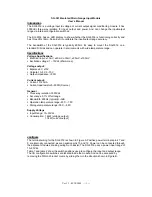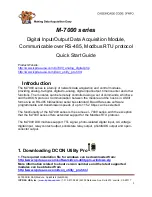
159
ECLYPSE APEX
Shielded cable offers better overall electrical noise immunity than non-shielded cable. Unshielded ca-
ble or cable of a different gauge may provide acceptable performance for shorter data bus segments
in environments with low ambient noise.
Cable Type
Part Number
O.D. (Ø)
300 meters (1000 feet), 24 AWG Stranded, Twisted Pair Shielded Cable
– FT6, Rated for Plenum Applications
CB-BACN6BL1000
3.75mm (0.148 in.)
Table 30: Distech Controls Recommended Cable Types for Modbus RTU Data Buses
Distech Controls Modbus RTU cable offers the best performance over the full range of baud rates, ca-
ble lengths, and number of connected devices. This is primarily due to lower conductor-to-conductor
capacitance of this cable.
Data Bus Topology and EOL Terminations
Function of EOL Terminations
The first and last device on the data bus must have End-of-Line (EOL) termination resistors connected
across the two data lines/wires of the twisted pair. These resistors serve the following purposes:
£
EOL terminations dampen reflections on the data bus that result from fast-switching (high-speed
rising and falling data edges) that otherwise would cause multiple data edges to be seen on the
data bus with the ensuing data corruption that may result. The higher the baud rate a data bus is
operating at, the more important that EOL terminations be properly implemented. Electrically, EOL
terminations dampen reflections by matching the impedance to that of a typical twisted pair cable.
£
EIA-485 data bus transmitters are tri-state devices. Meaning, they can electrically transmit 1, 0,
and an idle state. When the transmitter is in the idle state, it is effectively offline or disconnected
from the data bus. EOL terminations serve to bias (pull-down and pull-up) each data line/wire
when the lines are not being driven by any device. When an un-driven data bus is properly biased
by the EOL terminations to known voltages, this provides increased noise immunity on the data
bus by reducing the likelihood that induced electrical noise on the data bus is interpreted as actual
data.
When to Use EOL Terminations
EOL terminations should only be enabled / installed on the two devices located at either end of the
data bus. All other devices must have the EOL terminations disabled / uninstalled. If a Modbus RTU
device at the end of the data bus does not have a built-in EOL termination, then add a 120 Ohm resis-
tor across the device’s terminals.
Typical BACnet Device
First and last daisy-chained device:
- EOL Terminations are ENABLED
OR EOL resistor is installed
All other Devices:
- EOL Terminations are DISABLED
N
E
T+
N
E
T
-
Typical BACnet Device
N
E
T+
N
E
T
-
Typical BACnet Device
N
E
T+
N
E
T
-
Typical BACnet Device
N
E
T+
N
E
T
-
EOL ON
EOL OFF
EOL OFF
EOL OFF
Data Bus: Shielded Twisted Pair Cable
Electrical
System
Ground
RS-485
-
+
S
ECLYPSE
EOL ENABLED:
When the
ECLYPSE control-
ler is the first or
last daisy-chained
device, set the
external EOL
termination to
END
END
EOL ON
Figure 132: EOL Terminations Must be Enabled at Both the First and Last Device on the Data Bus
Devices with built-in EOL terminations are factory-set with the EOL termination disabled by default.
The
BACnet/IP to MS/TP Adapter
does not have EOL Termination (and Modbus RTU Data Bus biasing) capabilities
to be used at the end of a Modbus RTU data bus. Instead, use the
BACnet/IP to MS/TP Router
for this application.
Modbus RTU Communication Data Bus Fundamentals
Summary of Contents for ECLYPSE APEX
Page 1: ...User Guide ECLYPSE APEX...
Page 171: ...ECLYPSE APEX_UG_11_EN...













































